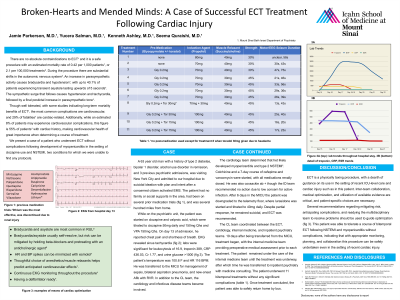Cardiology
(005) Broken Hearts and Mended Minds: a Case of Successful Electroconvulsive Therapy Treatment Following Cardiac Injury


Jamie Parkerson, MD (she/her/hers)
Resident
Mount Sinai Beth Israel
New York, New York
Yucera K. Salman, MD
PGY-2
Mount Sinai Beth Israel
Brooklyn, New York
Kenneth B. Ashley, MD, FACLP, DLFAPA
Associate Professor
Icahn School of Medicine at Mount Sinai
New York, New York- SQ
Seema Quraishi, MD
Division Chief and Fellowship Program Director, Consultation-Liaison Psychiatry
Mount Sinai Beth Israel
New York, New York
Presenting Author(s)
Co-Author(s)
Background: Although there are no absolute contraindications to electroconvulsive therapy (ECT), there are degrees of risk, with cardiovascular comorbidities and predispositions being of particular concern. We present a case of a patient who underwent ECT without complications following development of myopericarditis in the setting of clozapine use and NSTEMI, two conditions for which we were unable to find any published protocols regarding ECT.
Case: A 63 year old man with a past medical history of type 2 diabetes, psychiatric history of bipolar disorder, 3 previous psychiatric admissions, and numerous medication trials was visiting New York City from another state and was admitted to our hospital due to active suicidal ideation with plan and intent. The patient had no local family or social support and was several hundred miles from home. He had previously been trialed on lithium, paliperidone, buspirone, mirtazapine, hydroxyzine, aripiprazole, cariprazine, desvenlafaxine, risperidone, quetiapine, sertraline, vilazodone, naltrexone, and acamprosate. The most effective medication had been lithium, which was discontinued due to renal injury.
The patient was started on clozapine and valproic acid. After several days, the patient reported chest pain and shortness of breath. Due to concern for an acute coronary syndrome, he was transferred to the ICU and found to have bibasilar pneumonia. He was seen by the cardiology team, who determined that the patient likely developed myopericarditis as well as an NSTEMI. The patient was stabilized and transferred to the medical floor, where he was started on lurasidone at the recommendation of the CL team. He remained suicidal on this regimen, and it was determined that ECT would be appropriate and necessary to ensure the patient would be stable enough to safely return home, though his physical health was a cause for concern regarding safety and tolerability.
Discussion: As there are no absolute contraindications to ECT (Watts et al, 2021; Nordenskjold et al, 2022) and the patient had not reached stabilization through pharmacological intervention, it was determined that ECT would be appropriate. We collaborated with several other teams and utilized protocols that were previously described for administering ECT after STEMI (Hermida et al, 2022) to help guide treatment, monitoring, and medical optimization.
The patient was able to tolerate a course of bitemporal ECT following NSTEMI and suspected clozapine-induced myopericarditis without complications, indicating that with appropriate monitoring and collaboration this procedure can be safely undertaken following cardiac injury.
Conclusion/Implications: There is little evidence to guide treatment and scarce data regarding the safety, tolerability, morbidity, or mortality of ECT following cardiovascular insults such as myopericarditis or NSTEMI. In this case we used guidelines that have been utilized for STEMI patients to devise a safe, tolerable, and multidisciplinary plan to administer ECT, which was tolerated well and without complications. Collaboration from a number of services including internal medicine, cardiology, inpatient psychiatry, CL psychiatry, and the neuromodulation team was required in order to care for this medically, psychiatrically, and socially complex patient, and he was successfully stabilized and able to return home.
References: available upon request
Presentation Eligibility: Not previously published or presented
Diversity, Equity, and Inclusion: The patient’s socioeconomic challenges and limited social supports were central to this case, as this patient had to be stabilized not only in order to continue care in the outpatient setting, but in order to tolerate inter-state travel to return home independently.

